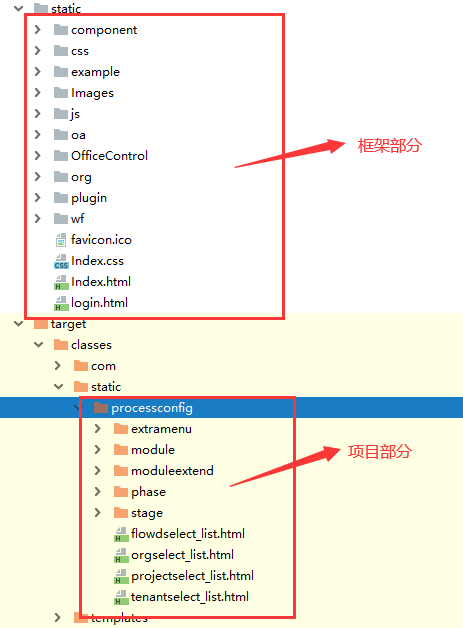SpringBoot静态资源访问控制和封装集成方案
背景
最近在着手公司框架优化及项目实际应用,原先方案是springboot+html前后端分离单独部署,后端人员兼职前端开发,后续产品线业务进行优化,面向企业使用部分由移动网站人员负责设计开发,内部配置后台管理还是由后端负责,随着框架不停迭代与使用的项目越来越多,项目升级框架变得十分麻烦,后端部分可以通过maven私服进行版本迭代,后台管理页面升级则需要进行各个项目拷贝,所以决定对框架进行整合,将后台管理页面与框架后端代码进行整合发布。
结构设计
- 框架打包后台管理相关标准资源及页面(框架public文件夹)
- 项目使用框架,开发具体业务配置管理页面(项目static文件夹)
- 项目需要个性化框架页面时,在项目static文件夹建立与框架同目录同名称资源文件进行覆盖,访问时优先级高于框架目录

SpringBoot静态资源访问
自定义访问路径
自定义WebConfig实现WebMvcConfigurer,重写addResourceHandlers方法
@Configuration
public class WebConfig implements WebMvcConfigurer {
@Value("${system.projectName}")
private String projectName;
/**
* 添加静态资源文件,外部可以直接访问地址
*
* @param registry
*/
@Override
public void addResourceHandlers(ResourceHandlerRegistry registry) {
//第一个方法设置访问路径前缀,第二个方法设置资源路径
registry.addResourceHandler("/" + projectName + "/**").addResourceLocations("classpath:/static/","classpath:/public/","file:static/");
}
}
图标与字体文件夹访问失败问题
将静态文件拷贝到static/public/resource文件夹下访问时,图标与字体文件会进行过滤导致损坏,需要在pom文件中进行设置
<build>
<resources>
<resource>
<filtering>true</filtering>
<directory>src/main/resources</directory>
<excludes>
<exclude>**/*.woff</exclude>
<exclude>**/*.ttf</exclude>
<exclude>**/*.ico</exclude>
</excludes>
</resource>
<resource>
<filtering>false</filtering>
<directory>src/main/resources</directory>
<includes>
<include>**/*.woff</include>
<include>**/*.ttf</include>
<include>**/*.ico</include>
</includes>
</resource>
</resources>
</build>
自定义欢迎页面
在对静态内目录设置自定义访问路径替换原有的/**后,无法找到目录下的index页面,需要建立拦截器手动进行判断,效果为访问http://localhost:port/projectName 会自动跳转到 http://localhost:port/projectName/index.html
@Component
public class PageRedirectInterceptor implements HandlerInterceptor {
@Value("${system.projectName}")
private String projectName;
@Override
public boolean preHandle(HttpServletRequest request, HttpServletResponse response, Object handler) throws Exception {
String requestURL = request.getRequestURL().toString();
String scheme = request.getScheme();
String servaerName = request.getServerName();
int port = request.getServerPort();
String rootPageURL = scheme + ":" + "//" + servaerName + ":" + port + "/" + projectName;
if (requestURL.equals(rootPageURL)) {
response.sendRedirect(request.getContextPath() + "/"+projectName + "/index.html");
return false;
}
return true;
}
}
自定义页面图标
在对静态内目录设置自定义访问路径替换原有的/**后,无法找到目录下的favcion.ico图标,需要在页面引用统一js统一设置,同时需要在配置文件中关闭默认图标,替换spring的小叶子
spring:
mvc:
favicon:
enabled: false
function GetRootPath() {
var loc = window.location,
host = loc.hostname,
protocol = loc.protocol,
port = loc.port ? (':' + loc.port) : '';
var path = location.pathname;
if (path.indexOf('/') === 0) {
path = path.substring(1);
}
var mypath = '/' + path.split('/')[0];
path = (mypath != undefined ? mypath : ('/' + loc.pathname.split('/')[1])) + '/';
var rootPath = protocol + '//' + host + port + path;
return rootPath;
}
var iconurl = GetRootPath()+"favicon.ico"
document.write('<link rel="shortcut icon" href= ' + iconurl + ' rel="external nofollow" rel="external nofollow" ></link>');
项目访问框架静态资源
框架静态资源文件获取
项目启动时,因为是引用框架的jar包,我们需要先找到指定jar包,再将jar包进行解压,找到对应目录将资源拷贝到我们需要的地方便于访问
扫描jar包
public static void copyFrameStaticFile() {
String packageName = "com.haopan.frame";
// 获取包的名字 并进行替换
String packageDirName = packageName.replace('.', '/');
// 定义一个枚举的集合 并进行循环来处理这个目录下的things
Enumeration<URL> dirs;
try {
dirs = Thread.currentThread().getContextClassLoader().getResources(packageDirName);
// 循环迭代下去
while (dirs.hasMoreElements()) {
// 获取下一个元素
URL url = dirs.nextElement();
// 得到协议的名称
String protocol = url.getProtocol();
if ("jar".equals(protocol)) {
// 如果是jar包文件
// 定义一个JarFile
JarFile jar;
try {
// 获取jar
jar = ((JarURLConnection) url.openConnection()).getJarFile();
String templateDecompressPath = "tempfiles/decompress/" + CommonUtil.getNewGuid() + "/";
File targetFile = new File(templateDecompressPath);
if (!targetFile.exists()) {
targetFile.mkdirs();
}
decompressJarFile(jar, templateDecompressPath);
String frameStaticPath = templateDecompressPath + "public/";
File frameStaticFile = new File(frameStaticPath);
if (frameStaticFile.exists()) {
String copyTargetPath = "static/";
File copyTargetFolder = new File(copyTargetPath);
if (copyTargetFolder.exists()) {
FileUtil.deleteDirectory(copyTargetPath);
}
copyTargetFolder.mkdirs();
FileUtil.copyFileFolder(frameStaticPath, copyTargetPath);
}
FileUtil.deleteDirectory(templateDecompressPath);
System.out.println("框架静态文件复制完毕!");
} catch (IOException e) {
e.printStackTrace();
}
}
}
} catch (IOException e) {
e.printStackTrace();
}
}
解压jar包
对JarFile中的JarEntry对象进行遍历,判断是文件还是目录分类处理
public static synchronized void decompressJarFile(JarFile jf,String outputPath){
if (!outputPath.endsWith(File.separator)) {
outputPath += File.separator;
}
File dir = new File(outputPath);
if (!dir.exists()) {
dir.mkdirs();
}
try{
for (Enumeration<JarEntry> e = jf.entries(); e.hasMoreElements();) {
JarEntry je = (JarEntry) e.nextElement();
String outFileName = outputPath + je.getName();
File f = new File(outFileName);
if(je.isDirectory()){
if(!f.exists()){
f.mkdirs();
}
}else{
File pf = f.getParentFile();
if(!pf.exists()){
pf.mkdirs();
}
InputStream in = jf.getInputStream(je);
OutputStream out = new BufferedOutputStream(
new FileOutputStream(f));
byte[] buffer = new byte[2048];
int nBytes = 0;
while ((nBytes = in.read(buffer)) > 0) {
out.write(buffer, 0, nBytes);
}
out.flush();
out.close();
in.close();
}
}
}catch(Exception e){
System.out.println("解压"+jf.getName()+"出错---"+e.getMessage());
}finally{
if(jf!=null){
try {
jf.close();
File jar = new File(jf.getName());
if(jar.exists()){
jar.delete();
}
} catch (IOException e) {
e.printStackTrace();
}
}
}
}
拷贝目录到指定位置
public class FileUtil {
private static void copy(String f1, String f2) throws IOException {
File file1=new File(f1);
/* File file2=new File(f2);*/
File[] flist=file1.listFiles();
for (File f : flist) {
if(f.isFile()){
copyFile(f.getPath(),f2+"/"+f.getName()); //调用复制文件的方法
//System.out.println("原路径["+f.getPath()+"] 被复制路径["+f2+"/"+f.getName()+"]");
}else if(f.isDirectory()){
copyFileFolder(f.getPath(),f2+"/"+f.getName()); //调用复制文件夹的方法
//System.out.println("原路径["+f.getPath()+"] 被复制路径["+f2+"/"+f.getName()+"]");
}
}
}
/**
* 复制文件夹
* @throws IOException
*/
public static void copyFileFolder(String sourceFolderPath,String targetFolderPath) throws IOException {
//创建文件夹
File file=new File(targetFolderPath);
if(!file.exists()){
file.mkdirs();
}
copy(sourceFolderPath,targetFolderPath);
}
/**
* 复制文件
* @throws IOException
*/
public static void copyFile(String sourceFilePath, String tagretFilePath) throws IOException {
try {
InputStream in = new FileInputStream(sourceFilePath);
OutputStream out = new FileOutputStream(tagretFilePath);
byte[] buffer = new byte[2048];
int nBytes = 0;
while ((nBytes = in.read(buffer)) > 0) {
out.write(buffer, 0, nBytes);
}
out.flush();
out.close();
in.close();
} catch (FileNotFoundException e) {
e.printStackTrace();
}
}
public static boolean delete(String fileName) {
File file =new File(fileName);
if (!file.exists()) {
//System.out.println("删除文件失败:" + fileName +"不存在!");
return false;
}else {
if (file.isFile())
return deleteFile(fileName);
else
return deleteDirectory(fileName);
}
}
/**
* 删除单个文件
*
* @param fileName:要删除的文件的文件名
* @return 单个文件删除成功返回true,否则返回false
*/
public static boolean deleteFile(String fileName) {
File file =new File(fileName);
// 如果文件路径所对应的文件存在,并且是一个文件,则直接删除
if (file.exists() && file.isFile()) {
if (file.delete()) {
//System.out.println("删除单个文件" + fileName +"成功!");
return true;
}else {
//System.out.println("删除单个文件" + fileName +"失败!");
return false;
}
}else {
//System.out.println("删除单个文件失败:" + fileName +"不存在!");
return false;
}
}
/**
* 删除目录及目录下的文件
*
* @param dir:要删除的目录的文件路径
* @return 目录删除成功返回true,否则返回false
*/
public static boolean deleteDirectory(String dir) {
// 如果dir不以文件分隔符结尾,自动添加文件分隔符
if (!dir.endsWith(File.separator))
dir = dir + File.separator;
File dirFile =new File(dir);
// 如果dir对应的文件不存在,或者不是一个目录,则退出
if ((!dirFile.exists()) || (!dirFile.isDirectory())) {
System.out.println("删除目录失败:" + dir +"不存在!");
return false;
}
boolean flag =true;
// 删除文件夹中的所有文件包括子目录
File[] files = dirFile.listFiles();
for (int i =0; i < files.length; i++) {
// 删除子文件
if (files[i].isFile()) {
flag = deleteFile(files[i].getAbsolutePath());
if (!flag)
break;
}
// 删除子目录
else if (files[i].isDirectory()) {
flag = deleteDirectory(files[i].getAbsolutePath());
if (!flag)
break;
}
}
if (!flag) {
//System.out.println("删除目录失败!");
return false;
}
// 删除当前目录
if (dirFile.delete()) {
//System.out.println("删除目录" + dir +"成功!");
return true;
}else {
return false;
}
}
}
外部静态资源访问与优先级设置
设置yml文件中的static-locations配置项,多个使用,隔开,同时指定顺序为访问的优先级
spring:
resources:
static-locations: classpath:static/,classpath:public/,file:static/
最终目录结构图如下,框架部分完全是项目启动时自动解压拷贝的,项目部分则是由具体项目进行开发,项目部分也可以很方便的进行框架部分功能重构,例如登录页,主页面修改等,本方式支持jar包和war包两种打包方式

- 点赞
- 收藏
- 关注作者


评论(0)